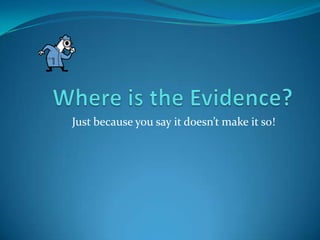Where is the evidence session e
The document discusses the importance of providing clear, consistent, and convincing evidence in teaching portfolios. It states that assessors will focus on evaluating the evidence provided by candidates, not on suggesting improvements. Candidates should draw their own conclusions about student learning and how it relates to their instructional goals and standards. The three main sources of evidence are the portfolio, analysis/reflection, and video examples. Clear evidence is distinct and easy to understand, while consistent evidence says the same things repeatedly and is not contradictory. Convincing evidence is credible and persuasive, using multiple pieces of evidence. Candidates are advised to include student work samples, descriptions of modifications made and feedback given, and examples of individualized instruction and analyzing student work.

Recommended
More Related Content
What's hot
What's hot (17)
Similar to Where is the evidence session e
Similar to Where is the evidence session e (20)
Recently uploaded
Recently uploaded (20)
Where is the evidence session e
- 1. Where is the Evidence? Just because you say it doesn’t make it so!
- 2. Evidence of what? Student Learning in light of your goals The Standards
- 3. What is the evidence? The three sources of evidence are: The portfolio Your description, analysis, and reflection The video The work samples
- 4. Where is the evidence? Assessors are instructed to only Identify Record evaluate The evidence that candidates provide. “Missing” evidence is not identified. They focus on the evaluation of evidence, not on suggestions for improvement.
- 5. Where is the evidence? Assessors do not like to infer. They want you to draw the conclusions about your practice and student learning in light of the standards and your goals. They want you to provide the clear, consistent, and convincing evidence.
- 6. Think, Write, Pair, Share What is the difference between Clear evidence Consistent evidence Convincing evidence Limited evidence
- 7. Limited Evidence Vague, unclear Few examples Lacking a rationale or weak rationale imbalance in entry-some parts strong, some parts weak Weak links
- 8. Clear Evidence Distinct, unclouded Ease of vision; vivid Clear links All points clarified Rationales given Antonyms-vague, dim, mysterious
- 9. Consistent Evidence Conforming to a single set of principles Solid You say it again and again Not contradictory All parts are clear
- 10. Convincing Evidence Credible, believable Causing to believe as by proof Persuasive Multiple pieces of evidence present
- 11. What is the evidence? What did the kids do? (parents/peers/community-Entry 4) What did the kids say? What did the kids write? What were the kids’ questions? What were the kids’ misconceptions? How do you show your expertise? WHAT DOES ALL THIS GIVE YOU? EVIDENCE!!!
- 12. Where is the evidence? For student work-based portfolio entries focus on submitting and analyzing samples that show: Teaching and learning related to a worthwhile goal Your modifications to strategies/sequencing to meet the needs of the students Your meaningful feedback Your ability to individualize instruction Your ability to analyze student work
- 13. Where is the evidence? Analysis is a part of every question after #1. When you analyze you: Tell why, so what, how Give rationales for events and your choices Explain your interpretation of what happened and what you think should come next and why Deal with motives and reasons Discuss the significance of work samples Don’t just describe
- 14. Where is the evidence? For videotape-based portfolio entries choose the segment that: Shows teaching and learning related to a worthwhile instructional goal Shows active learning by students Shows you engaging students in effective discussion appropriate to the goals Shows teacher to student and student to student interactions
- 15. Where is the evidence? Since you can’t tell them everything, just tell them what is important! 1. Answer the question. Use the analysis questions to take you deeper 2. Focus on your rubric. What specific aspects of the standards are being assessed based on rubrics.
- 16. Remember Don’t just tell! You must infer. Give your rationale as to why the kids said what they said, and what they did. Infer about why the lesson worked or didn’t and how you know. Discuss how you know the kids reached the goals partially or completely. You have to connect the dots and make the links for the assessors. Show them the smoking gun. JUST BECAUSE YOU SAY IT, DOESN’T MAKE IT SO!!! Where is the evidence?